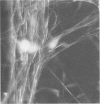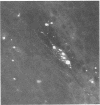Abstract
The axonal transport of rabies virus (challenge virus strain of fixed virus) was studied in differentiated rat embryonic dorsal root ganglion cells. In addition, we observed the attachment of rabies virus to neuronal extensions and virus production by infected neurons. A compartmentalized cell culture system was used, allowing infection and manipulation of neuronal extensions without exposing the neural soma to the virus. The cultures consisted of 60% large neuronal cells whose extensions exhibited neurofilament structures. Rabies virus demonstrated high binding affinity to unmyelinated neurites, as suggested by assays of virus adsorption and immunofluorescence studies. The rate of axoplasmic transport of virus was 12 to 24 mm/day, including the time required for internalization of the virus into neurites. The virus transport could be blocked by cytochalasin B, vinblastine, and colchicine, none of which negatively affected the production of virus in cells once the infection was established. It was concluded that, for the retrograde transfer of rabies virus by neurites from the periphery to the neuronal soma, the integrity of tubulin- and actin-containing structures is essential. The rat sensory neurons were characterized as permissive, moderately susceptible, but low producers of rabies virus. These neurons were capable of harboring rabies virus for long periods of time and able to release virus into the culture medium without showing any morphological alterations. The involvement of sensory neurons in rabies virus pathogenesis, both in viral transport and as a site for persistent viral infection, is discussed.
Full text
PDF








Images in this article
Selected References
These references are in PubMed. This may not be the complete list of references from this article.
- Adams R. J., Bray D. Rapid transport of foreign particles microinjected into crab axons. Nature. 1983 Jun 23;303(5919):718–720. doi: 10.1038/303718a0. [DOI] [PubMed] [Google Scholar]
- Atanasiu P., Tsiang H., Gamet A. Nouveau vaccin antirabique humain de culture cellulaire primaire. Ann Microbiol (Paris) 1974 Oct-Nov;125B(3):419–432. [PubMed] [Google Scholar]
- Bak I. J., Markham C. H., Cook M. L., Stevens J. G. Intraaxonal transport of Herpes simplex virus in the rat central nervous system. Brain Res. 1977 Nov 18;136(3):415–429. doi: 10.1016/0006-8993(77)90067-1. [DOI] [PubMed] [Google Scholar]
- Beckerle M. C. Microinjected fluorescent polystyrene beads exhibit saltatory motion in tissue culture cells. J Cell Biol. 1984 Jun;98(6):2126–2132. doi: 10.1083/jcb.98.6.2126. [DOI] [PMC free article] [PubMed] [Google Scholar]
- Bensch K. G., Malawista S. E. Microtubular crystals in mammalian cells. J Cell Biol. 1969 Jan;40(1):95–107. doi: 10.1083/jcb.40.1.95. [DOI] [PMC free article] [PubMed] [Google Scholar]
- Brown S. S., Spudich J. A. Mechanism of action of cytochalasin: evidence that it binds to actin filament ends. J Cell Biol. 1981 Mar;88(3):487–491. doi: 10.1083/jcb.88.3.487. [DOI] [PMC free article] [PubMed] [Google Scholar]
- Bulenga G., Heaney T. Post-exposure local treatment of mice infected with rabies with two axonal flow inhibitors, colchicine and vinblastine. J Gen Virol. 1978 May;39(2):381–385. doi: 10.1099/0022-1317-39-2-381. [DOI] [PubMed] [Google Scholar]
- Burrage T. G., Tignor G. H., Smith A. L. Rabies virus binding at neuromuscular junctions. Virus Res. 1985 Apr;2(3):273–289. doi: 10.1016/0168-1702(85)90014-0. [DOI] [PubMed] [Google Scholar]
- Campenot R. B. Local control of neurite development by nerve growth factor. Proc Natl Acad Sci U S A. 1977 Oct;74(10):4516–4519. doi: 10.1073/pnas.74.10.4516. [DOI] [PMC free article] [PubMed] [Google Scholar]
- Cook M. L., Stevens J. G. Pathogenesis of herpetic neuritis and ganglionitis in mice: evidence for intra-axonal transport of infection. Infect Immun. 1973 Feb;7(2):272–288. doi: 10.1128/iai.7.2.272-288.1973. [DOI] [PMC free article] [PubMed] [Google Scholar]
- DEAN D. J., EVANS W. M., MCCLURE R. C. PATHOGENESIS OF RABIES. Bull World Health Organ. 1963;29:803–811. [PMC free article] [PubMed] [Google Scholar]
- Dal Canto M. C., Barbano R. L., Jubelt B. Ultrastructural immunohistochemical localization of poliovirus during virulent infection of mice. J Neuropathol Exp Neurol. 1986 Nov;45(6):613–618. doi: 10.1097/00005072-198611000-00001. [DOI] [PubMed] [Google Scholar]
- Dichter M. A., Tischler A. S., Greene L. A. Nerve growth factor-induced increase in electrical excitability and acetylcholine sensitivity of a rat pheochromocytoma cell line. Nature. 1977 Aug 11;268(5620):501–504. doi: 10.1038/268501a0. [DOI] [PubMed] [Google Scholar]
- Dietzschold B., Wiktor T. J., Trojanowski J. Q., Macfarlan R. I., Wunner W. H., Torres-Anjel M. J., Koprowski H. Differences in cell-to-cell spread of pathogenic and apathogenic rabies virus in vivo and in vitro. J Virol. 1985 Oct;56(1):12–18. doi: 10.1128/jvi.56.1.12-18.1985. [DOI] [PMC free article] [PubMed] [Google Scholar]
- Fuller A. O., Spear P. G. Specificities of monoclonal and polyclonal antibodies that inhibit adsorption of herpes simplex virus to cells and lack of inhibition by potent neutralizing antibodies. J Virol. 1985 Aug;55(2):475–482. doi: 10.1128/jvi.55.2.475-482.1985. [DOI] [PMC free article] [PubMed] [Google Scholar]
- Gillet J. P., Derer P., Tsiang H. Axonal transport of rabies virus in the central nervous system of the rat. J Neuropathol Exp Neurol. 1986 Nov;45(6):619–634. doi: 10.1097/00005072-198611000-00002. [DOI] [PubMed] [Google Scholar]
- Harrison A. K., Murphy F. A. Lyssavirus infection of muscle spindles and motor end plates in striated muscle of hamsters. Arch Virol. 1978;57(2):167–175. doi: 10.1007/BF01315678. [DOI] [PubMed] [Google Scholar]
- Iwasaki Y., Clark H. F. Cell to cell transmission of virus in the central nervous system. II. Experimental rabies in mouse. Lab Invest. 1975 Oct;33(4):391–399. [PubMed] [Google Scholar]
- Iwasaki Y., Liu D. S., Yamamoto T., Konno H. On the replication and spread of rabies virus in the human central nervous system. J Neuropathol Exp Neurol. 1985 Mar;44(2):185–195. doi: 10.1097/00005072-198503000-00007. [DOI] [PubMed] [Google Scholar]
- Jacobs J. R., Stevens J. K. Changes in the organization of the neuritic cytoskeleton during nerve growth factor-activated differentiation of PC12 cells: a serial electron microscopic study of the development and control of neurite shape. J Cell Biol. 1986 Sep;103(3):895–906. doi: 10.1083/jcb.103.3.895. [DOI] [PMC free article] [PubMed] [Google Scholar]
- Johnson R. T. Experimental rabies. Studies of cellular vulnerability and pathogenesis using fluorescent antibody staining. J Neuropathol Exp Neurol. 1965 Oct;24(4):662–674. [PubMed] [Google Scholar]
- Kaluza G., Lell G., Reinacher M., Stitz L., Willems W. R. Neurogenic spread of Semliki Forest virus in mice. Arch Virol. 1987;93(1-2):97–110. doi: 10.1007/BF01313896. [DOI] [PubMed] [Google Scholar]
- Kimberlin R. H., Walker C. A. Pathogenesis of scrapie (strain 263K) in hamsters infected intracerebrally, intraperitoneally or intraocularly. J Gen Virol. 1986 Feb;67(Pt 2):255–263. doi: 10.1099/0022-1317-67-2-255. [DOI] [PubMed] [Google Scholar]
- Klein R. J. The pathogenesis of acute, latent and recurrent herpes simplex virus infections. Arch Virol. 1982;72(3):143–168. doi: 10.1007/BF01348961. [DOI] [PubMed] [Google Scholar]
- Kristensson K., Lycke E., Röyttä M., Svennerholm B., Vahlne A. Neuritic transport of herpes simplex virus in rat sensory neurons in vitro. Effects of substances interacting with microtubular function and axonal flow [nocodazole, taxol and erythro-9-3-(2-hydroxynonyl)adenine]. J Gen Virol. 1986 Sep;67(Pt 9):2023–2028. doi: 10.1099/0022-1317-67-9-2023. [DOI] [PubMed] [Google Scholar]
- Kucera P., Dolivo M., Coulon P., Flamand A. Pathways of the early propagation of virulent and avirulent rabies strains from the eye to the brain. J Virol. 1985 Jul;55(1):158–162. doi: 10.1128/jvi.55.1.158-162.1985. [DOI] [PMC free article] [PubMed] [Google Scholar]
- Lycke E., Kristensson K., Svennerholm B., Vahlne A., Ziegler R. Uptake and transport of herpes simplex virus in neurites of rat dorsal root ganglia cells in culture. J Gen Virol. 1984 Jan;65(Pt 1):55–64. doi: 10.1099/0022-1317-65-1-55. [DOI] [PubMed] [Google Scholar]
- MacLean-Fletcher S., Pollard T. D. Mechanism of action of cytochalasin B on actin. Cell. 1980 Jun;20(2):329–341. doi: 10.1016/0092-8674(80)90619-4. [DOI] [PubMed] [Google Scholar]
- Murphy F. A. Rabies pathogenesis. Arch Virol. 1977;54(4):279–297. doi: 10.1007/BF01314774. [DOI] [PubMed] [Google Scholar]
- Reibman J., Haines K. A., Rich A. M., Cristello P., Giedd K. N., Weissmann G. Colchicine inhibits ionophore-induced formation of leukotriene B4 by human neutrophils: the role of microtubules. J Immunol. 1986 Feb 1;136(3):1027–1032. [PubMed] [Google Scholar]
- Schroer T. A., Brady S. T., Kelly R. B. Fast axonal transport of foreign synaptic vesicles in squid axoplasm. J Cell Biol. 1985 Aug;101(2):568–572. doi: 10.1083/jcb.101.2.568. [DOI] [PMC free article] [PubMed] [Google Scholar]
- Smith A. L., Tignor G. H., Mifune K., Motohashi T. Isolation and assay of rabies serogroup viruses in CER cells. Intervirology. 1977;8(2):92–99. doi: 10.1159/000148883. [DOI] [PubMed] [Google Scholar]
- Sung J. H., Hayano M., Mastri A. R., Okagaki T. A case of human rabies and ultrastructure of the Negri body. J Neuropathol Exp Neurol. 1976 Sep-Oct;35(5):541–559. doi: 10.1097/00005072-197609000-00006. [DOI] [PubMed] [Google Scholar]
- Superti F., Derer M., Tsiang H. Mechanism of rabies virus entry into CER cells. J Gen Virol. 1984 Apr;65(Pt 4):781–789. doi: 10.1099/0022-1317-65-4-781. [DOI] [PubMed] [Google Scholar]
- Superti F., Hauttecoeur B., Morelec M. J., Goldoni P., Bizzini B., Tsiang H. Involvement of gangliosides in rabies virus infection. J Gen Virol. 1986 Jan;67(Pt 1):47–56. doi: 10.1099/0022-1317-67-1-47. [DOI] [PubMed] [Google Scholar]
- Tsiang H., Derer M., Taxi J. An in vivo and in vitro study of rabies virus infection of the rat superior cervical ganglia. Arch Virol. 1983;76(3):231–243. doi: 10.1007/BF01311107. [DOI] [PubMed] [Google Scholar]
- Tsiang H. Evidence for an intraaxonal transport of fixed and street rabies virus. J Neuropathol Exp Neurol. 1979 May;38(3):286–299. doi: 10.1097/00005072-197905000-00008. [DOI] [PubMed] [Google Scholar]
- Tsiang H., Guillon J. C. Presence of specific antigens in neuronal cells infected with fixed and street rabies virus strains. Acta Neuropathol. 1981;55(4):263–267. doi: 10.1007/BF00690988. [DOI] [PubMed] [Google Scholar]
- Tsiang H., Koulakoff A., Bizzini B., Berwald-Netter Y. Neurotropism of rabies virus. An in vitro study. J Neuropathol Exp Neurol. 1983 Jul;42(4):439–452. doi: 10.1097/00005072-198307000-00006. [DOI] [PubMed] [Google Scholar]
- Tsiang H., Superti F. Ammonium chloride and chloroquine inhibit rabies virus infection in neuroblastoma cells. Brief report. Arch Virol. 1984;81(3-4):377–382. doi: 10.1007/BF01310010. [DOI] [PubMed] [Google Scholar]
- Tsiang H., de la Porte S., Ambroise D. J., Derer M., Koenig J. Infection of cultured rat myotubes and neurons from the spinal cord by rabies virus. J Neuropathol Exp Neurol. 1986 Jan;45(1):28–42. doi: 10.1097/00005072-198601000-00003. [DOI] [PubMed] [Google Scholar]
- Tyler K. L., McPhee D. A., Fields B. N. Distinct pathways of viral spread in the host determined by reovirus S1 gene segment. Science. 1986 Aug 15;233(4765):770–774. doi: 10.1126/science.3016895. [DOI] [PubMed] [Google Scholar]
- Ziegler R. J., Herman R. E. Peripheral infection in culture of rat sensory neurons by herpes simplex virus. Infect Immun. 1980 May;28(2):620–623. doi: 10.1128/iai.28.2.620-623.1980. [DOI] [PMC free article] [PubMed] [Google Scholar]









